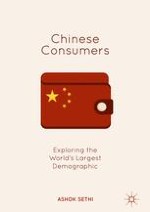2019 | OriginalPaper | Buchkapitel
4. Key Segments of Chinese Consumers
Aktivieren Sie unsere intelligente Suche, um passende Fachinhalte oder Patente zu finden.
Wählen Sie Textabschnitte aus um mit Künstlicher Intelligenz passenden Patente zu finden. powered by
Markieren Sie Textabschnitte, um KI-gestützt weitere passende Inhalte zu finden. powered by
Abstract
-
Gray consumers, who through sheer numbers in China offer a huge and a largely untapped market, which most marketers are slow to exploit
-
Young couples, who are not only large in number but also at or approaching the peak of consumption, as they buy to get the best out of life as well as nurture the family
-
China’s singles, which is a growing population as more and more people lead their life by themselves, voluntarily or by force of circumstance as they are unable to find a mate
-
Chinese centennials, who are the youngest and the most distinctive of the consumer groups(These four groups mentioned above are mutually exclusive and collectively form the large part of the consumers in China)
-
Chinese millennials, who may have very little in common with their Western counterparts, as they grew up and came of age in an entirely different environment
-
Chinese women consumers, who because of their own means of income (China has one of the largest proportion of women working outside the home) have created an enormous market
-
Lower tier city consumers and migrant workers, who offer unique characteristics because of their background and where they come from
